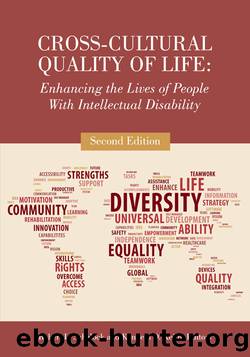Cross-Cultural Quality of Life by Schalock Robert L.;Keith Kenneth D.;

Author:Schalock, Robert L.;Keith, Kenneth D.; [Schalock, Robert L.; Keith, Kenneth D.]
Language: eng
Format: epub
ISBN: 6424019
Publisher: AAIDD
Published: 2016-09-15T00:00:00+00:00
CHAPTER 12
THE SUPPORTS PARADIGM
ROGER J. STANCLIFFE, SAMUEL R. C. ARNOLD, and VIVIENNE C. RICHES
Introduction and Overview
Supports have been defined by the American Association on Intellectual and Developmental Disabilities (AAIDD) as âresources and strategies that aim to promote the development, education, interests, and personal well-being of a person and that enhance individual functioningâ (Schalock et al., 2010, p. 105). As such, supports represent a broad concept including, but not limited to, adaptive equipment (e.g., computerized text readers), universal design and/or environmental modifications (e.g., signs in public places using symbols instead of text), and personal support from an individual such as a caregiver. In this chapter we focus on paid and unpaid personal supports provided by other people. We recognize that other forms of support are important and interact with personal supports. For example, the availability of a power wheelchair reduces the need for personal support for mobility (e.g., a caregiver pushing a wheelchair).
The nature of support is values-driven and relates to the outcomes intended to be achieved through provision of support. The AAIDD definition of ID includes the assumption that âwith appropriate personalized supports over a sustained period, the life functioning of the person with intellectual disability will improveâ (Schalock et al., 2010, p. 1). In discussing support and providing examples of what we consider to be appropriate support, we will deliberately highlight support that is enabling.
For example, students need to travel to school each day. In Australia, for example, many students without disabilities travel to school by public transportation, whereas students with disability are often provided with specialized, segregated, door-to-door travel. Haveman, Tillmann, Stoppler, Kvas, and Monninger (2013) showed that many, but not all, students with ID can learn to travel to school independently by public transportation; yet Australian governments spend large amounts of money transporting students with disabilities, but little or nothing on travel skills training. For many students, such specialized transport is a potentially disabling form of support that creates unnecessary long-term dependence. Travel skills training is enabling, not only for the journey to school, but also as a basis for future independent travel to work or for leisure. In addition, such enabling support has the potential to free current support resources to provide support for other important outcomes to be achieved.
In this chapter we will briefly describe the supports paradigm and examine a variety of examples of how supports have been operationalized. Specifically, we will analyze (a) what is the supports paradigm, (b) conceptualization of support needs, (c) support-needs assessment, (d) resource allocation, (e) active support, (f) support, function, and outcomes, and (g) culture and support. As appropriate, these analyses will focus on the individual level (microsystem), the organization level (mesosystem), and the level of service systems and society (macrosystem).
What is the Supports Paradigm?
In the IDD field, the supports paradigm has been described in detail by a number of authors in recent years (Buntinx, & Schalock, 2010; Luckasson et al., 2002; Schalock, 2004b) and is a central feature of the AAIDD conceptualization of ID (Schalock et al., 2010).
Download
This site does not store any files on its server. We only index and link to content provided by other sites. Please contact the content providers to delete copyright contents if any and email us, we'll remove relevant links or contents immediately.
The Chimp and the River by David Quammen(823)
Plague of Corruption by Kent Heckenlively(686)
The Chimp and the River: How AIDS Emerged from an African Forest by David Quammen(639)
Illness as Metaphor and AIDS and Its Metaphors by Susan Sontag(627)
Body Counts by Sean Strub(621)
Borrowed Time: An AIDS Memoir by Paul Monette(581)
Dr. Kellon's Guide to First Aid for Horses by Eleanor Kellon(572)
Inventing the AIDS Virus by Peter H. Duesberg(539)
Borrowed Time by Paul Monette(488)
I Die, But The Memory Lives On by Henning Mankell(423)
Body Counts: A Memoir of Politics, Sex, AIDS, and Survival by Strub Sean(418)
First Aid for Dogs by Dr Justin Wimpole(416)
Living with HIV by Mark Cichocki RN(312)
My Name is Mary by Mary Fisher(238)
How to Have Theory in an Epidemic: Cultural Chronicles of AIDS (Series Q) by Paula A. Treichler(236)
Last Watch of the Night: Essays Too Personal and Otherwise by Monette Paul(230)
Cross-Cultural Quality of Life by Schalock Robert L.;Keith Kenneth D.;(175)
A compendium of TCM patterns & treatments by Flaws Bob 1946-(81)
The Sheldon Short Guide to Stroke Recovery by Mark Greener(76)
